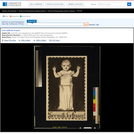
Poster showing an infant. Title from item.
- Subject:
- History
- U.S. History
- Material Type:
- Diagram/Illustration
- Primary Source
- Provider:
- Library of Congress
- Provider Set:
- Library of Congress - World War I Posters
- Date Added:
- 06/18/2013

Poster showing an infant. Title from item.

This course covers the history and aesthetics of French cinema from the advent of sound to present-day. It treats films in the context of technical processes, the art of narration, directorial style, role of the scriptwriter, the development of schools and movements, the impact of political events and ideologies, and the relation between French and other national cinemas.
Taught in English, the films are screened with English subtitles. Students may complete written assignments in French.

This course introduces students to the world of French photography from its invention in the 1820s to the present. It provides exposure to major photographers and images of the French tradition, and encourages students to explore the social and cultural roles and meanings of photographs. Designed to help students navigate their own photo-saturated worlds, it also provides opportunity to gain practical experience in photography. Taught in English.
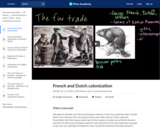
In the 1600s, French and Dutch settlers in North America took a very different approach to colonization than their English or Spanish counterparts. In this video, Kim examines the trading relationships that French and Dutch settlers established with Native Americans in North America and how colonial goals affected patterns of settlement.

Scene depicting French women in war-time. One woman is working in a factory, one is nursing her child, and another woman is hoeing in the field. In the background is an outline of Victory. French women made up over 40 percent of the work force during the war. Over two million were recruited into positions in heavy industry. Films were used for the first time as entertainment at Les Foyers du Soldats for soldiers on leave, and also to keep the homefront abreast of activities of the war in a romantic and humanizing way. Signed: G. Capon. Promotional goal: Fr. K8.J7. 1917//Fr. F34.J7. 1917. Item is no. 233 & 283 in a printed checklist available in the Library of Congress Prints and Photographs Reading Room.

This course focuses on main currents in contemporary German literary and visual culture. Taking Nietzsche’s thought as a point of departure, students will survey the dialectics of tradition and modernity in both Germany and other European countries, particularly the UK, France, Denmark, and Poland. Primary works are drawn from literature, cinema, art, and performance, including works by Peter Sloterdijk, Thomas Vinterberg, and Michel Houellebecq.

This kit provides the materials and background information needed to engage students in a dynamic and constructive process of learning how global media perspectives differ based on country of production, media source, target audience, and political and social context. There are five lessons representing important issues and media documents from: Africa (news and documentary film clips about the food crisis), Latin America (editorial cartoons about immigration), Europe (news and documentary film clips about Islam and cultural identity), India (magazine covers about India's rise in the global economy), and Southeast Asia (websites concerning Islamic majorities and minorities).
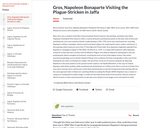
Baron Antoine-Jean Gros, Napoleon Bonaparte Visiting the Pest House in Jaffa, 1804, oil on canvas, 209 x 280 inches (Musée du Louvre, Paris) Speakers: Dr. Beth Harris and Dr. Steven Zucker. Note: Gros was a student of the Neo-Classical painter David, however, this painting, sometimes also titled, Napoleon Visiting the Pest House in Jaffa, is a proto-Romantic painting that points to the later style of Gericault and Delacroix. Gros was trained in David's studio between 1785-1792, and is most well known for recording Napoleon's military campaigns, which proved to be ideal subjects for exploring the exotic, violent, and heroic. In this painting, which measures more than 17 feet high and 23 feet wide, Gros depicted a legendary episode from Napoleon's campaigns in Egypt (1798-1801). Created by Beth Harris and Steven Zucker.
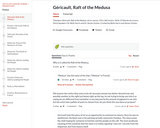
Théodore Géricault, Raft of the Medusa, oil on canvas, 193 x 282 inches, 1818-19 (Musée du Louvre, Paris) Speakers: Dr. Beth Harris and Dr. Steven Zucker. Created by Beth Harris and Steven Zucker.

Speakers: Dr. Beth Harris and Dr. Steven Zucker. Created by Beth Harris and Steven Zucker.

U.S. Food Administration poster showing women in France pulling plows; includes quotes by Alonzo Taylor, Herbert Hoover, and Woodrow Wilson. Issued(?) by: United States Food Administration.
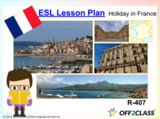
Notre Dame, Marseille, Montpellier. If you’re looking to add a bit of color and culture to your student’s reading activities, this new ESL Lesson Plan on holiday in France offers just the ticket.Suitable for intermediate learners, the lesson plan is built around the theme of holidays. It offers students the chance to practice their reading skills while learning about intensifiers, idioms and informal language.If you want additional lesson plans and support, including teachers’ notes, be sure to register for a free Off2Class account.

Short Description:
Né d’un projet de recherche multidisciplinaire, ce livre s’intéresse à la manière dont les publics méditerranéens, en particulier en Algérie et en France, reçoivent et utilisent des images médiatiques, qu’elles soient prétexte à polémique ou favorisent les échanges. Les études proposées analysent ainsi la réception de productions variées (bande dessinée, dessin d’actualité, film, web film) dans des contextes divers (école, université, festival, cinéma, télévision, presse écrite, web news, réseaux sociaux). Elles éclairent la manière dont ces publics construisent leur identité culturelle et se représentent les rapports Nord-Sud au travers de six thèmes : les conflits, les formes récentes d’esclavagisme, les migrations, les langues, les rapports femmes-hommes ainsi que le rôle des associations et des institutions publiques dans la coopération et les échanges interculturels entre la France et l’Afrique du Nord.
Long Description:
Né d’un projet de recherche multidisciplinaire, ce livre s’intéresse à la manière dont les publics méditerranéens, en particulier en Algérie et en France, reçoivent et utilisent des images médiatiques, qu’elles soient prétexte à polémique ou favorisent les échanges. Les études proposées analysent ainsi la réception de productions variées (bande dessinée, dessin d’actualité, film, web film) dans des contextes divers (école, université, festival, cinéma, télévision, presse écrite, web news, réseaux sociaux). Elles éclairent la manière dont ces publics construisent leur identité culturelle et se représentent les rapports Nord-Sud au travers de six thèmes : les conflits, les formes récentes d’esclavagisme, les migrations, les langues, les rapports femmes-hommes ainsi que le rôle des associations et des institutions publiques dans la coopération et les échanges interculturels entre la France et l’Afrique du Nord.
Word Count: 57466
ISBN: 978-2-924661-84-0
(Note: This resource's metadata has been created automatically by reformatting and/or combining the information that the author initially provided as part of a bulk import process.)
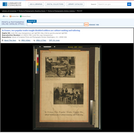
Exhibit poster showing two scenes in which disabled soldiers are being taught useful skills to enable them to find employment upon discharge from military service - "Disabled Serbians working in the carpentry shop at Lyons, France" ; "A tailoring class in Paris taught by a one-legged instructor." Exhibit of the Red Cross Institute for Crippled and Disabled Men and the Red Cross Institute for the Blind.
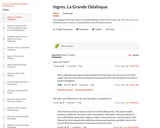
Jean-Auguste-Dominique Ingres, La Grande Odalisque, 1814, Oil on canvas, 36" x 63" (91 x 162 cm), (Musée du Louvre, Paris). Created by Beth Harris and Steven Zucker.
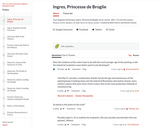
Jean-Auguste-Dominique Ingres, Princesse de Broglie, oil on canvas, 1851–53 (The Metropolitan Museum of Art). Speakers: Dr. Beth Harris, Dr. Steven Zucker. Created by Beth Harris and Steven Zucker.
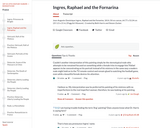
Jean-Auguste-Dominique Ingres, Raphael and the Fornarina, 1814, Oil on canvas, 64.77 x 53.34 cm (25 1/2 x 21 in.) (Fogg Art Museum) . Created by Beth Harris and Steven Zucker.

Everyday we are bombarded with the word “global” and encouraged to see globalization as the quintessential transformation of our age. But what exactly does “globalization” mean? How is it affecting the lives of people around the world, not only in economic, but social and cultural terms? How do contemporary changes compare with those from other historical periods? Are such changes positive, negative or simply inevitable? And, finally, how does the concept of the “global” itself shape our perceptions in ways that both help us understand the contemporary world and potentially distort it? This course begins by offering a brief overview of historical “world systems,” including those centered in Asia as well as Europe. It explores the nature of contemporary transformations, including those in economics, media & information technologies, population flows, and consumer habits, not through abstractions but by focusing on the daily lives of people in various parts of the world. This course considers such topics as the day-to-day impact of computers in Silicon Valley and among Tibetan refugees; the dilemmas of factory workers in the US and rural Java; the attractions of Bombay cinema in Nigeria, the making of rap music in Japan, and the cultural complexities of immigrant life in France. This course seeks not only to understand the various forms globalization takes, but to understand its very different impacts world-wide.

Poster showing a Red Cross nurse among small children, some with French flags, as a woman on her knees hands the nurse an infant.
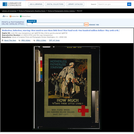
Poster showing a Red Cross nurse among small children, some with French flags, as a woman on her knees hands the nurse an infant. Form N.Y. 20 Second War Fund.